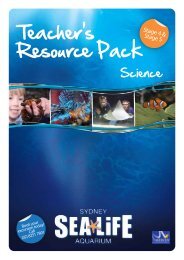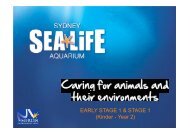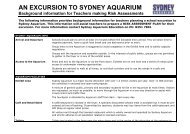Teacher's Resource Pack - Sydney Aquarium
Teacher's Resource Pack - Sydney Aquarium
Teacher's Resource Pack - Sydney Aquarium
You also want an ePaper? Increase the reach of your titles
YUMPU automatically turns print PDFs into web optimized ePapers that Google loves.
Movement & Senses<br />
These resources look closely at two of the core life processes; movement and senses. The<br />
incredible range of species at SEA LIFE <strong>Sydney</strong> <strong>Aquarium</strong> will help your students see that animals<br />
can move in many different ways. You can take it further in the classroom with role-plays and<br />
discussion about the way each animal’s body affects the way it moves. Students will also look at<br />
the role of the senses and the sensory organs.<br />
<strong>Resource</strong>s provided<br />
Student Worksheet 1<br />
Movement PowerPoint slides<br />
Pre & Post Lessons<br />
Lesson 1:<br />
Introduction: How do you move?<br />
Introduce core life processes using the slides.<br />
Ask students to think about the different way<br />
they can move and make a list of as many<br />
different ways that they can think of (for<br />
example, running, jumping or crawling).<br />
Ask students to demonstrate some of these<br />
types of movement.<br />
<strong>Resource</strong>s:<br />
Slides 1-3<br />
Learning Task:<br />
Make out the movement<br />
Explain that different animals which live<br />
under the sea can move in lots of different<br />
ways.<br />
Students should look at the pictures and<br />
descriptions on Student Worksheet 1 and<br />
work out which description applies to each<br />
animal.<br />
Students can cut out the description and<br />
stick it in the box next to the relevant animal.<br />
<strong>Resource</strong>s:<br />
Student Worksheet 1<br />
Slides 4-5<br />
Closing Task:<br />
Acting like an animal<br />
Show the class the animals on slides 6-10.<br />
Ask students to suggest how that animal<br />
moves. As a class act out that movement.<br />
<strong>Resource</strong>s:<br />
Slides 6-10<br />
Lesson 2:<br />
Learning Task: Animal Art<br />
Ask students to draw a picture of a sea<br />
animal and then using play dough or clay; ask<br />
them to make a 3D version of their sea<br />
animal.<br />
Ask students, ‘What words would you use to<br />
describe how your animal moves?’<br />
<strong>Resource</strong>s:<br />
Play dough/clay, paper and pencils/markers<br />
Lesson 3: Excursion to<br />
SEA LIFE <strong>Sydney</strong> <strong>Aquarium</strong><br />
During your visit<br />
Ask students to look for three creatures<br />
which move in very different ways. Ask them<br />
to also see how each of the three animals<br />
chosen breathes and sees.<br />
Lesson 4:<br />
Introduction: Senses Quiz<br />
Introduce students to the different senses<br />
using the slides.<br />
Use the PowerPoint slides to run the Senses<br />
Quiz.<br />
Students should look at the sense organs<br />
shown on the slides and decide which of the<br />
three animals listed it belongs to. Click on<br />
the name of the animals to find out if they<br />
are right. If the class is wrong, then ask them<br />
to try again.<br />
Once you have worked out which animal the<br />
sensory organ belongs to, ask them to name<br />
which sense it is associated with.<br />
<strong>Resource</strong>s:<br />
Slides 11-34<br />
Learning Task:<br />
Invent a Sense<br />
Ask students to think of a brand new sense<br />
which could help them in their day to day<br />
life.<br />
Ask them to write a short paragraph<br />
explaining the sense and how they use it – or<br />
ask them to draw a picture of themselves<br />
using that sense.<br />
<strong>Resource</strong>s:<br />
None required<br />
Lesson 5:<br />
Learning Task: Senseless<br />
Collect a number of items with strange<br />
textures.<br />
Place each of the items in a separate box<br />
with a hole in the lid.<br />
Learning objectives<br />
● Know that all animals move and<br />
have senses.<br />
● Understand that different animals<br />
move in different ways.<br />
● Know that other animals’ senses<br />
can be different to a human’s.<br />
Syllabus areas<br />
● Science and Technology<br />
● Drama<br />
● Visual Art<br />
● English<br />
Wow facts!<br />
● Seahorses can move each of<br />
their eyes independently – so<br />
they can look forwards and<br />
backwards at the same time!<br />
● Sea jellies do not have brains<br />
● Dugongs can hold their breath<br />
for up to 8 minutes!<br />
● Rays breathe through special<br />
holes behind their eyes.<br />
● A tuna never stops swimming<br />
during its lifetime. Every year it<br />
swims as far as to the moon and<br />
back!<br />
● By using their lateral line, fish can<br />
find other fish through sensing<br />
tiny vibrations.<br />
Blindfold students and ask them to take it in<br />
turns putting their hands in the box. Once<br />
they have felt the object inside tell them to<br />
write down what they think it is.<br />
Once students have tried all the boxes, ask<br />
for their answers.<br />
Explain that living underwater can mean that<br />
some animals cannot use some senses (deep<br />
sea fish cannot see due to a lack of light for<br />
example).<br />
Explain that some animals make up for this<br />
by developing other strong senses.<br />
<strong>Resource</strong>s:<br />
Boxes with a hole cut in the top of each one<br />
Objects with strange textures<br />
Blindfolds<br />
2








